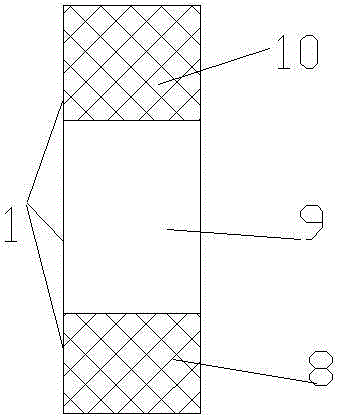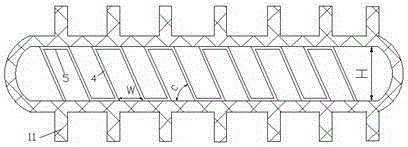Inner-fin heat pipe
A technology of heat pipes and fins, which is applied in the field of inner fin heat pipes, can solve the problems of heat pipe heat transfer coefficient reduction, local uneven heat transfer, uneven heat transfer, etc., to reduce fluid pressure, avoid local overheating, and extend heat pipes The effect of longevity
- Summary
- Abstract
- Description
- Claims
- Application Information
AI Technical Summary
Problems solved by technology
Method used
Image
Examples
Embodiment Construction
[0048] The specific embodiments of the present invention will be described in detail below in conjunction with the accompanying drawings.
[0049] In this article, if there is no special explanation, when it comes to formulas, " / " means division, and "×" and "*" mean multiplication.
[0050] like figure 1 As shown, a heat pipe 1 includes an evaporating end 8 and a condensing end 10, and preferably also includes an adiabatic end 9. The evaporating end 8 absorbs heat, the fluid sealed in the heat pipe evaporates, and then the fluid enters the condensing end 10, and the heat is transferred through the condensing end to the outside, and then the fluid after heat exchange becomes a liquid, and then flows to the evaporation end 8.
[0051] like figure 2 As shown, the heat pipe 1 includes a flat tube, and the flat tube includes tube walls 3 parallel to each other, and a fluid channel 2 is formed between the adjacent tube walls 3 . Fins 7 are arranged inside the flat tube 1 , pref...
PUM
 Login to View More
Login to View More Abstract
Description
Claims
Application Information
 Login to View More
Login to View More - R&D
- Intellectual Property
- Life Sciences
- Materials
- Tech Scout
- Unparalleled Data Quality
- Higher Quality Content
- 60% Fewer Hallucinations
Browse by: Latest US Patents, China's latest patents, Technical Efficacy Thesaurus, Application Domain, Technology Topic, Popular Technical Reports.
© 2025 PatSnap. All rights reserved.Legal|Privacy policy|Modern Slavery Act Transparency Statement|Sitemap|About US| Contact US: help@patsnap.com



